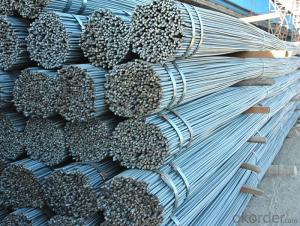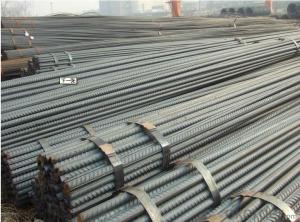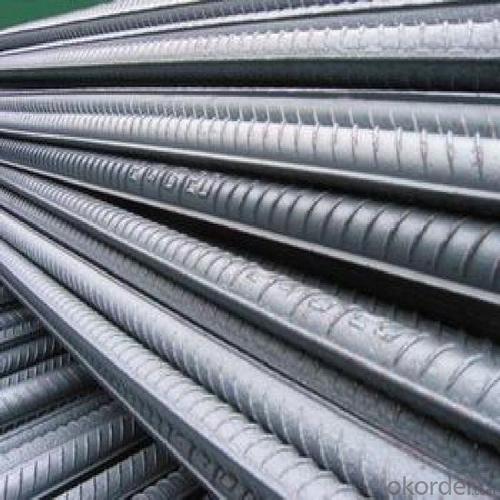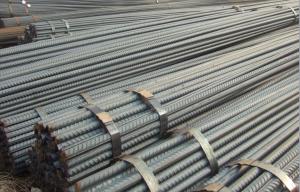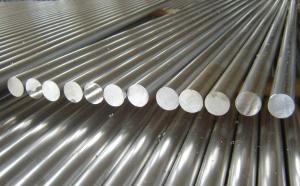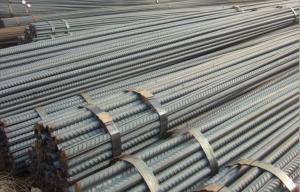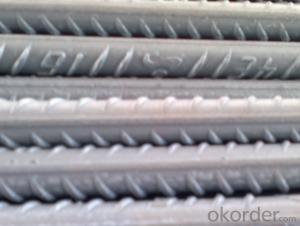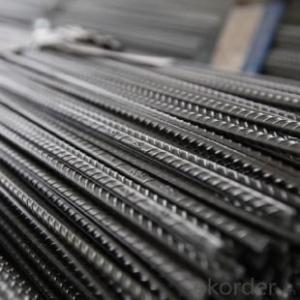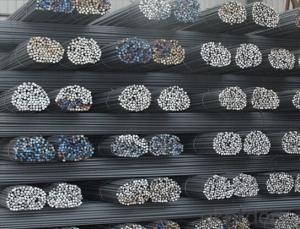Deformed Bar BS4449-1997/2009 or GB HRB400 6MM-50MM
- Loading Port:
- China Main Port
- Payment Terms:
- TT or LC
- Min Order Qty:
- -
- Supply Capability:
- -
OKorder Service Pledge
OKorder Financial Service
You Might Also Like
Product Description:
OKorder is offering high quality Deformed Bar BS4449-1997/2009 or GB HRB400 6MM-50MMat great prices with worldwide shipping. Our supplier is a world-class manufacturer of steel, with our products utilized the world over. OKorder annually supplies products to European, North American and Asian markets. We provide quotations within 24 hours of receiving an inquiry and guarantee competitive prices.
Product Applications:
Deformed bar is widely used in buildings, bridges, roads and other engineering construction. Big to highways, railways, bridges, culverts, tunnels, public facilities such as flood control, dam, small to housing construction, beam, column, wall and the foundation of the plate, deformed bar is an integral structure material. With the development of world economy and the vigorous development of infrastructure construction, real estate, the demand for deformed bar will be larger and larger
Product Advantages:
OKorder's Deformed Bar BS4449-1997/2009 or GB HRB400 6MM-50MMare durable, strong, and resist corrosion, exact size, regular package, chemical and mechanical properties are stable.
Main Product Features:
· Premium quality
· Prompt delivery & seaworthy packing (30 days after receiving deposit)
· Corrosion resistance
· Can be recycled and reused
· Mill test certification
· Professional Service
· Competitive pricing
Product Specifications:
Manufacture: Hot rolled
Grade: BS4449
Certificates: ISO, SGS, BV, CIQ
Diameter: 6mm,8mm,10mm,12mm,14mm,16mm,18mm,20mm,
22mm,25mm,28mm,32mm,36mm,40mm,50mm
Length: 6M, 9M,12M or as required
Packaging: Export packing, nude packing, bundled
Chemical Composition: (Please kindly find our chemistry of our material based on HRB500 as below for your information)
Grade | Technical data of the original chemical composition (%) | ||||||
C | Mn | Si | S | P | V | ||
HRB400 | ≤0.25 | ≤1.60 | ≤0.80 | ≤0.045 | ≤0.045 | 0.04-0.12 | |
Physical capability | |||||||
Yield Strength (N/cm²) | Tensile Strength (N/cm²) | Elongation (%) | |||||
≥400 | ≥570 | ≥14 | |||||
Theoretical weight and section area of each diameter as below for your information:
Diameter(mm) | Section area (mm²) | Mass(kg/m) | Weight of 12m bar(kg) |
6 | 28.27 | 0.222 | 2.664 |
8 | 50.27 | 0.395 | 4.74 |
10 | 78.54 | 0.617 | 7.404 |
12 | 113.1 | 0.888 | 10.656 |
14 | 153.9 | 1.21 | 14.52 |
16 | 201.1 | 1.58 | 18.96 |
18 | 254.5 | 2.00 | 24 |
20 | 314.2 | 2.47 | 29.64 |
22 | 380.1 | 2.98 | 35.76 |
25 | 490.9 | 3.85 | 46.2 |
28 | 615.8 | 4.83 | 57.96 |
32 | 804.2 | 6.31 | 75.72 |
36 | 1018 | 7.99 | 98.88 |
40 | 1257 | 9.87 | 118.44 |
50 | 1964 | 15.42 | 185.04 |
FAQ:
Q1: Why buy Materials & Equipment from OKorder.com?
A1: All products offered byOKorder.com are carefully selected from China's most reliable manufacturing enterprises. Through its ISO certifications, OKorder.com adheres to the highest standards and a commitment to supply chain safety and customer satisfaction.
Q2: How do we guarantee the quality of our products?
A2: We have established an advanced quality management system which conducts strict quality tests at every step, from raw materials to the final product. At the same time, we provide extensive follow-up service assurances as required.
Q3: How soon can we receive the product after purchase?
A3: Within three days of placing an order, we will begin production. The specific shipping date is dependent upon international and government factors, but is typically 7 to 10 workdays.
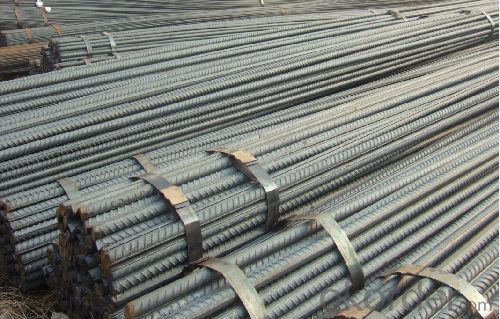
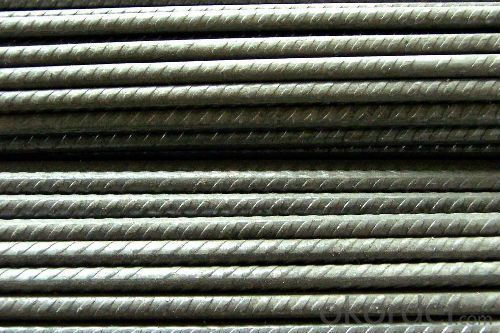
- Q: What is the effect of chloride ions on steel rebars?
- The presence of chloride ions in the environment can have a detrimental effect on steel rebars. Chloride ions can penetrate the protective oxide layer on the surface of the steel and react with the iron atoms, leading to the formation of iron chloride compounds. These compounds are highly corrosive and can cause the rebars to rust and eventually weaken. This corrosion process, known as chloride-induced corrosion, can significantly reduce the structural integrity and lifespan of steel rebars, posing a risk to the overall stability of reinforced concrete structures. Therefore, it is crucial to protect steel rebars from chloride exposure through proper design, construction, and maintenance practices to ensure their long-term durability and safety.
- Q: What are the main uses of steel rebars?
- The main uses of steel rebars include reinforcing concrete structures, such as buildings, bridges, and highways, to increase their strength and durability. They are also used in the construction of retaining walls, tunnels, and other underground structures. Additionally, steel rebars are commonly utilized in the manufacturing of various industrial equipment and machinery.
- Q: What is the tensile strength of different grades of steel rebars?
- The tensile strength of different grades of steel rebars can vary depending on the specific grade. Generally, steel rebars range in tensile strength from 400 to 600 megapascals (MPa) for lower grade rebars, while higher grade rebars can have tensile strengths ranging from 600 to 900 MPa or even higher.
- Q: What are the fire resistance properties of steel rebars?
- Steel rebars have excellent fire resistance properties. Due to their high melting point and low thermal conductivity, steel rebars can withstand high temperatures and maintain their structural integrity during a fire. This makes them a reliable choice for reinforcing concrete structures in fire-prone areas.
- Q: 10 less than three rebar refers to the rebar?
- Grade steel HPB235, grade three steel, HRB400. Where P represents light circle, and R indicates rib (thread).Numbers indicate the degree of flexion (which can be regarded as strength). Is that clear?
- Q: What is the impact of steel rebars on the constructability of a project?
- The constructability of a project is greatly affected by steel rebars, which play a vital role in reinforcing and providing structural integrity to concrete structures. By incorporating steel rebars, the overall strength, durability, and resilience of a construction project are significantly improved. One important impact of using steel rebars is the increased load-bearing capacity of the structure. Rebars are designed to withstand tension, complementing the concrete's ability to resist compression. This combination enhances the structural strength of the project, enabling it to withstand heavy loads and external forces, such as earthquakes or high winds. Moreover, steel rebars also enhance the ductility of the concrete structure. Ductility refers to the material's ability to deform without breaking. By adding rebars, the concrete becomes more flexible, allowing it to absorb energy and deform under stress before reaching its breaking point. This is particularly important in areas prone to seismic activities, as it helps prevent sudden and catastrophic failure of the structure. Another aspect of constructability affected by steel rebars is the overall lifespan of the project. The corrosion resistance properties of rebars, especially when coated or galvanized, significantly extend the lifespan of the structure. This is particularly relevant in environments with high humidity, coastal areas, or regions with harsh weather conditions. By preventing corrosion and maintaining the integrity of the rebars, the entire project's longevity and durability are greatly enhanced. Additionally, steel rebars also facilitate the construction process itself. Their availability in various lengths, shapes, and sizes allows for flexible and efficient design and construction. Contractors can easily cut, bend, and shape rebars to fit specific project requirements, reducing construction time and costs. Moreover, rebars can be prefabricated off-site, minimizing on-site labor and simplifying the construction process. In conclusion, the impact of steel rebars on the constructability of a project is highly significant. They improve the overall strength, load-bearing capacity, ductility, and lifespan of the structure. Additionally, the flexibility and ease of use of steel rebars contribute to efficient construction practices. Therefore, incorporating steel rebars into a project is essential for ensuring its structural integrity and long-term success.
- Q: Can steel rebars be used in structures with limited construction technology?
- Yes, steel rebars can be used in structures with limited construction technology. Steel rebars are commonly used in construction to reinforce concrete structures, providing strength and durability. They are versatile and can be used in various types of structures, such as buildings, bridges, and dams. In areas with limited construction technology, the use of steel rebars can still be feasible. The basic process of placing rebars involves bending and cutting them to the required sizes and shapes, and then placing them within the concrete forms before pouring the concrete. This process can be carried out using basic tools and equipment that are typically available in construction sites with limited resources. Additionally, the availability of steel rebars in various sizes and grades allows for flexibility in design and construction, making them suitable for a wide range of structures. The use of steel rebars ensures that the concrete structure can withstand various loads and forces, enhancing its overall strength and durability. While the availability of advanced construction technology may enhance the efficiency and precision of the construction process, it is not a prerequisite for using steel rebars. With proper training and expertise, construction workers can effectively use steel rebars in structures, even with limited technology, to create safe and reliable structures.
- Q: How are steel rebars cut and bent on-site?
- Steel rebars are cut and bent on-site using specialized equipment such as rebar cutters and benders. The rebars are measured, marked, and then cut to the required length using the cutter. After cutting, the rebars are placed into the bender machine where they are bent to the desired shape or angle. This process ensures that the rebars are tailored to fit the specific construction requirements of the project.
- Q: How do steel rebars affect the overall fire resistance of a structure?
- Steel rebars, which are commonly used in reinforced concrete structures, play a significant role in enhancing the overall fire resistance of a building. The presence of steel rebars provides structural stability and prevents the collapse of a building during a fire event. Steel is inherently fire-resistant and has a high melting point. When exposed to fire, the steel rebars heat up gradually, allowing them to maintain their integrity and structural strength. The slow heat transfer property of steel helps in preventing the spread of fire and slows down the rate at which the temperature rises. Moreover, the thermal conductivity of steel rebars is relatively lower compared to other construction materials, such as concrete. This property enables the steel rebars to act as a heat sink, absorbing and dissipating heat away from the vulnerable areas of the structure. By doing so, the rebars help in reducing the overall temperature within the building, thus extending the time before the critical temperature for structural failure is reached. Additionally, the presence of steel rebars in the concrete matrix creates a composite structure that benefits from the concrete's fire-resistant properties. Concrete has a high heat capacity and is known for its ability to resist fire and heat transfer. The combination of steel rebars and concrete creates a synergistic effect, enhancing the fire resistance of the structure. Furthermore, steel rebars contribute to the overall fire resistance by improving the load-bearing capacity of a building during a fire. The structural integrity provided by the steel rebars helps in maintaining the stability of the structure, preventing structural collapse, and facilitating safer evacuation. In conclusion, steel rebars have a positive impact on the overall fire resistance of a structure. They provide structural stability, slow down the rise in temperature, act as a heat sink, and enhance the load-bearing capacity. The combination of steel rebars and concrete creates a fire-resistant composite structure, thereby improving the safety and integrity of the building during a fire event.
- Q: What are the potential risks of using steel rebars in construction?
- Some potential risks of using steel rebars in construction include corrosion, inadequate bonding with concrete, and potential for structural failure if not properly installed or maintained. Additionally, steel rebars can conduct electricity, posing a risk in areas with electrical currents or lightning storms.
Send your message to us
Deformed Bar BS4449-1997/2009 or GB HRB400 6MM-50MM
- Loading Port:
- China Main Port
- Payment Terms:
- TT or LC
- Min Order Qty:
- -
- Supply Capability:
- -
OKorder Service Pledge
OKorder Financial Service
Similar products
Hot products
Hot Searches
Related keywords

